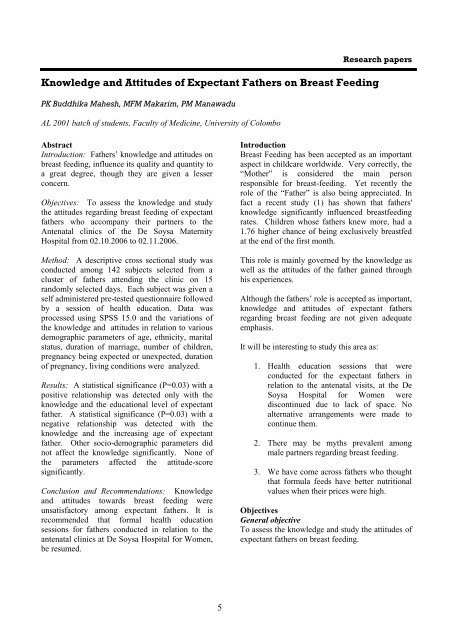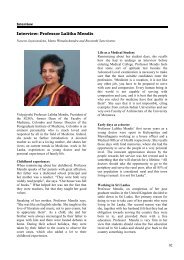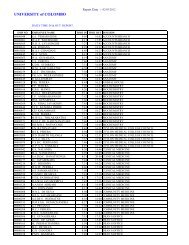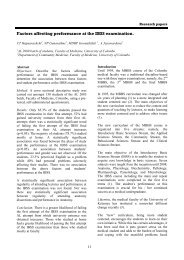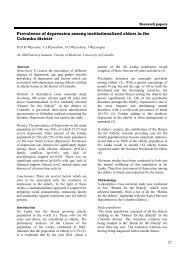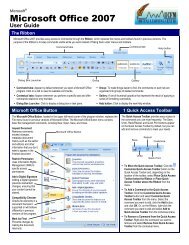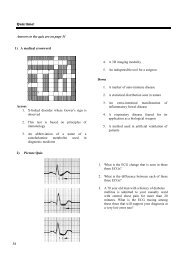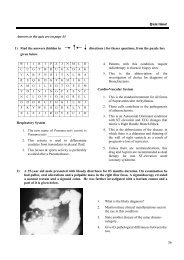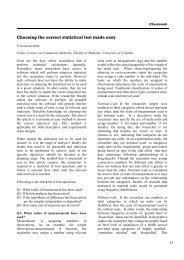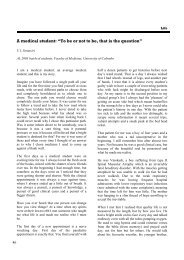Knowledge and Attitudes of Expectant Fathers on Breast - Faculty of ...
Knowledge and Attitudes of Expectant Fathers on Breast - Faculty of ...
Knowledge and Attitudes of Expectant Fathers on Breast - Faculty of ...
Create successful ePaper yourself
Turn your PDF publications into a flip-book with our unique Google optimized e-Paper software.
Research papers<str<strong>on</strong>g>Knowledge</str<strong>on</strong>g> <str<strong>on</strong>g>and</str<strong>on</strong>g> <str<strong>on</strong>g>Attitudes</str<strong>on</strong>g> <str<strong>on</strong>g>of</str<strong>on</strong>g> <str<strong>on</strong>g>Expectant</str<strong>on</strong>g> <str<strong>on</strong>g>Fathers</str<strong>on</strong>g> <strong>on</strong> <strong>Breast</strong> FeedingPK Buddhika Mahesh, MFM Makarim, PM ManawaduAL 2001 batch <str<strong>on</strong>g>of</str<strong>on</strong>g> students, <strong>Faculty</strong> <str<strong>on</strong>g>of</str<strong>on</strong>g> Medicine, University <str<strong>on</strong>g>of</str<strong>on</strong>g> ColomboAbstractIntroducti<strong>on</strong>: <str<strong>on</strong>g>Fathers</str<strong>on</strong>g>‟ knowledge <str<strong>on</strong>g>and</str<strong>on</strong>g> attitudes <strong>on</strong>breast feeding, influence its quality <str<strong>on</strong>g>and</str<strong>on</strong>g> quantity toa great degree, though they are given a lesserc<strong>on</strong>cern.Objectives: To assess the knowledge <str<strong>on</strong>g>and</str<strong>on</strong>g> studythe attitudes regarding breast feeding <str<strong>on</strong>g>of</str<strong>on</strong>g> expectantfathers who accompany their partners to theAntenatal clinics <str<strong>on</strong>g>of</str<strong>on</strong>g> the De Soysa MaternityHospital from 02.10.2006 to 02.11.2006.Method: A descriptive cross secti<strong>on</strong>al study wasc<strong>on</strong>ducted am<strong>on</strong>g 142 subjects selected from acluster <str<strong>on</strong>g>of</str<strong>on</strong>g> fathers attending the clinic <strong>on</strong> 15r<str<strong>on</strong>g>and</str<strong>on</strong>g>omly selected days. Each subject was given aself administered pre-tested questi<strong>on</strong>naire followedby a sessi<strong>on</strong> <str<strong>on</strong>g>of</str<strong>on</strong>g> health educati<strong>on</strong>. Data wasprocessed using SPSS 15.0 <str<strong>on</strong>g>and</str<strong>on</strong>g> the variati<strong>on</strong>s <str<strong>on</strong>g>of</str<strong>on</strong>g>the knowledge <str<strong>on</strong>g>and</str<strong>on</strong>g> attitudes in relati<strong>on</strong> to variousdemographic parameters <str<strong>on</strong>g>of</str<strong>on</strong>g> age, ethnicity, maritalstatus, durati<strong>on</strong> <str<strong>on</strong>g>of</str<strong>on</strong>g> marriage, number <str<strong>on</strong>g>of</str<strong>on</strong>g> children,pregnancy being expected or unexpected, durati<strong>on</strong><str<strong>on</strong>g>of</str<strong>on</strong>g> pregnancy, living c<strong>on</strong>diti<strong>on</strong>s were analyzed.Results: A statistical significance (P=0.03) with apositive relati<strong>on</strong>ship was detected <strong>on</strong>ly with theknowledge <str<strong>on</strong>g>and</str<strong>on</strong>g> the educati<strong>on</strong>al level <str<strong>on</strong>g>of</str<strong>on</strong>g> expectantfather. A statistical significance (P=0.03) with anegative relati<strong>on</strong>ship was detected with theknowledge <str<strong>on</strong>g>and</str<strong>on</strong>g> the increasing age <str<strong>on</strong>g>of</str<strong>on</strong>g> expectantfather. Other socio-demographic parameters didnot affect the knowledge significantly. N<strong>on</strong>e <str<strong>on</strong>g>of</str<strong>on</strong>g>the parameters affected the attitude-scoresignificantly.C<strong>on</strong>clusi<strong>on</strong> <str<strong>on</strong>g>and</str<strong>on</strong>g> Recommendati<strong>on</strong>s: <str<strong>on</strong>g>Knowledge</str<strong>on</strong>g><str<strong>on</strong>g>and</str<strong>on</strong>g> attitudes towards breast feeding wereunsatisfactory am<strong>on</strong>g expectant fathers. It isrecommended that formal health educati<strong>on</strong>sessi<strong>on</strong>s for fathers c<strong>on</strong>ducted in relati<strong>on</strong> to theantenatal clinics at De Soysa Hospital for Women,be resumed.Introducti<strong>on</strong><strong>Breast</strong> Feeding has been accepted as an importantaspect in childcare worldwide. Very correctly, the“Mother” is c<strong>on</strong>sidered the main pers<strong>on</strong>resp<strong>on</strong>sible for breast-feeding. Yet recently therole <str<strong>on</strong>g>of</str<strong>on</strong>g> the “Father” is also being appreciated. Infact a recent study (1) has shown that fathers'knowledge significantly influenced breastfeedingrates. Children whose fathers knew more, had a1.76 higher chance <str<strong>on</strong>g>of</str<strong>on</strong>g> being exclusively breastfedat the end <str<strong>on</strong>g>of</str<strong>on</strong>g> the first m<strong>on</strong>th.This role is mainly governed by the knowledge aswell as the attitudes <str<strong>on</strong>g>of</str<strong>on</strong>g> the father gained throughhis experiences.Although the fathers‟ role is accepted as important,knowledge <str<strong>on</strong>g>and</str<strong>on</strong>g> attitudes <str<strong>on</strong>g>of</str<strong>on</strong>g> expectant fathersregarding breast feeding are not given adequateemphasis.It will be interesting to study this area as:1. Health educati<strong>on</strong> sessi<strong>on</strong>s that werec<strong>on</strong>ducted for the expectant fathers inrelati<strong>on</strong> to the antenatal visits, at the DeSoysa Hospital for Women weredisc<strong>on</strong>tinued due to lack <str<strong>on</strong>g>of</str<strong>on</strong>g> space. Noalternative arrangements were made toc<strong>on</strong>tinue them.2. There may be myths prevalent am<strong>on</strong>gmale partners regarding breast feeding.3. We have come across fathers who thoughtthat formula feeds have better nutriti<strong>on</strong>alvalues when their prices were high.ObjectivesGeneral objectiveTo assess the knowledge <str<strong>on</strong>g>and</str<strong>on</strong>g> study the attitudes <str<strong>on</strong>g>of</str<strong>on</strong>g>expectant fathers <strong>on</strong> breast feeding.5
3rd secti<strong>on</strong> - This was designed to explore theattitudes that would influence breast-feeding.There were 10 statements with Likert scales <str<strong>on</strong>g>of</str<strong>on</strong>g>resp<strong>on</strong>ses bearing scores from 1 to 5. They wereasked to answer all <str<strong>on</strong>g>of</str<strong>on</strong>g> them.Study units were selected after informed verbalc<strong>on</strong>sent. The questi<strong>on</strong>naire itself provided thedetails <str<strong>on</strong>g>and</str<strong>on</strong>g> the purpose <str<strong>on</strong>g>of</str<strong>on</strong>g> the research. An<strong>on</strong>ymitywas secured <str<strong>on</strong>g>and</str<strong>on</strong>g> c<strong>on</strong>fidentiality maintained by notdisclosing the provided resp<strong>on</strong>ses to a third party.Once the questi<strong>on</strong>naires were administered thesubjects were instructed <strong>on</strong> the expected ways <str<strong>on</strong>g>of</str<strong>on</strong>g>answering <str<strong>on</strong>g>and</str<strong>on</strong>g> were asked to fill it within 20minutes. This was followed by a health educati<strong>on</strong>sessi<strong>on</strong> <strong>on</strong> the c<strong>on</strong>tent <str<strong>on</strong>g>of</str<strong>on</strong>g> the questi<strong>on</strong>naire by thenurse <str<strong>on</strong>g>of</str<strong>on</strong>g> the Health Educati<strong>on</strong> Unit to benefit theparticipants.Secti<strong>on</strong> 2 was given a score out <str<strong>on</strong>g>of</str<strong>on</strong>g> a total <str<strong>on</strong>g>of</str<strong>on</strong>g> 100whereas secti<strong>on</strong> 3 was given a score out <str<strong>on</strong>g>of</str<strong>on</strong>g> a total<str<strong>on</strong>g>of</str<strong>on</strong>g> 50. The statistical analysis was d<strong>on</strong>e with SPSS(13.0) <str<strong>on</strong>g>and</str<strong>on</strong>g> the significances were determined byChi-square Test.ResultsThe socio demographic data <str<strong>on</strong>g>of</str<strong>on</strong>g> the sample aredepicted in Table 1.Table 1: Socio-demographic dataAgeEthnicitySinhaleseOthersDurati<strong>on</strong> <str<strong>on</strong>g>of</str<strong>on</strong>g> living together4yrsNo <str<strong>on</strong>g>of</str<strong>on</strong>g> childrenN<strong>on</strong>e1>1Pregnancy statusExpectedUnexpectedDurati<strong>on</strong> <str<strong>on</strong>g>of</str<strong>on</strong>g> pregnancy6Educati<strong>on</strong> levelPrimarySec<strong>on</strong>daryO/LA/LTertiaryLiving statusCouple al<strong>on</strong>ewith parentsotherMean - 31yrs (SD-6.3)115 (81%)27 (19%)72 (51%)33 (23%)37 (26%)100 (70%)32 (23%)10 (7%)122 (86%)20 (14%)35 (25%)49 (35%)58 (40%)15 (10%)53 (37%)39 (28%)23 (16%)12 (9%)52 (37%)87 (61%)03 (2%)7
The results <str<strong>on</strong>g>of</str<strong>on</strong>g> the analysis for knowledge <str<strong>on</strong>g>and</str<strong>on</strong>g>attitudes for individual socio-demographicparameters are depicted in Table 2. A significancewas observed for the “Age” <str<strong>on</strong>g>and</str<strong>on</strong>g> the “Educati<strong>on</strong>level” with the knowledge score. “Age” showed anegative relati<strong>on</strong>ship with the knowledge asdepicted in Figure 1. Educati<strong>on</strong>al level <str<strong>on</strong>g>of</str<strong>on</strong>g> fathershowed a relati<strong>on</strong>ship with the knowledge asshown in Figure 2.Table 2: <str<strong>on</strong>g>Knowledge</str<strong>on</strong>g> <str<strong>on</strong>g>and</str<strong>on</strong>g> attitudes scores for socio-demographic parametersParameterP Value forknowledgeP value forattitudesAge 0.03 0.82Ethnicity 0.69 0.38Durati<strong>on</strong> <str<strong>on</strong>g>of</str<strong>on</strong>g> pregnancy 0.79 0.98Parity 0.72 0.56Status <str<strong>on</strong>g>of</str<strong>on</strong>g> pregnancy 0.38 0.58Durati<strong>on</strong> <str<strong>on</strong>g>of</str<strong>on</strong>g> pregnancy 0.48 0.69Educati<strong>on</strong> level 0.03 0.36Living status 0.26 0.76Figure 1: Distributi<strong>on</strong> <str<strong>on</strong>g>of</str<strong>on</strong>g> knowledge scores am<strong>on</strong>g age groups<str<strong>on</strong>g>Knowledge</str<strong>on</strong>g>Age in yearsFigure 2 Distributi<strong>on</strong> <str<strong>on</strong>g>of</str<strong>on</strong>g> knowledge scores according to educati<strong>on</strong> level<str<strong>on</strong>g>Knowledge</str<strong>on</strong>g>Educati<strong>on</strong>al level8
<str<strong>on</strong>g>Knowledge</str<strong>on</strong>g> <strong>on</strong> some issues was alarmingly poor.For example, that the need for cleaning <str<strong>on</strong>g>of</str<strong>on</strong>g> thebreasts prior to each feed was unnecessary, the factthat twins can be breast-fed <str<strong>on</strong>g>and</str<strong>on</strong>g> that invertednipples can be manipulated were not known byover 75% <str<strong>on</strong>g>of</str<strong>on</strong>g> the subjects. Further results aredepicted in table 3.Table 3: <str<strong>on</strong>g>Knowledge</str<strong>on</strong>g> <strong>on</strong> breast feedingStatements to test knowledgePercentage who knewthe correct answer (%)Cleaning the breasts prior to each feed is necessary 7.7Twins can be breast fed 18.3Inverted nipples can be manipulated 19A baby's crying is always due to inadequate feeding 33.1correct method <str<strong>on</strong>g>of</str<strong>on</strong>g> breast feeding 34.5A minor illness <str<strong>on</strong>g>of</str<strong>on</strong>g> the mother does not affect the baby 37.3there will be intrauterine growth retardati<strong>on</strong> if the motherc<strong>on</strong>ceives while c<strong>on</strong>tinuing to breast feedBoys need more breast milk than girls 3835.9The value <str<strong>on</strong>g>of</str<strong>on</strong>g> colostrum 47.2exclusive breast feeding for 6 m<strong>on</strong>ths is recommended 38drinking milk by the mother would increase their milk secreti<strong>on</strong> 42.3Discussi<strong>on</strong>The results show that there is a decline <str<strong>on</strong>g>of</str<strong>on</strong>g>knowledge score with the fathers‟ age. It might bedue to the more novel methods <str<strong>on</strong>g>of</str<strong>on</strong>g> educati<strong>on</strong>available to the younger generati<strong>on</strong> <str<strong>on</strong>g>and</str<strong>on</strong>g> their freshknowledge. The knowledge is more with theeducati<strong>on</strong>al level <str<strong>on</strong>g>of</str<strong>on</strong>g> the father up to the GCE A/L.Yet there is a slight decline in those who have hadtertiary educati<strong>on</strong>. Interestingly, the access toknowledge may be a factor for this advantage,where as the lack <str<strong>on</strong>g>of</str<strong>on</strong>g> time for c<strong>on</strong>cern, individualinterests <str<strong>on</strong>g>and</str<strong>on</strong>g> the field specializati<strong>on</strong> might be thecause for the decline in the group who had tertiaryeducati<strong>on</strong>.<str<strong>on</strong>g>Knowledge</str<strong>on</strong>g> level was higher in fathers who havealready had a child when compared to newlyexpectant fathers. This may be due to the previousexperiences.When the pregnancy was expected the knowledgewas more as they may have been preparing for theevent. However, when the couple were not legallymarried the knowledge scores decreased <str<strong>on</strong>g>and</str<strong>on</strong>g> itmay be due to unpreparedness <str<strong>on</strong>g>and</str<strong>on</strong>g> the lessresp<strong>on</strong>sibility the expectant father accepts.When the couples live with their parents theknowledge scores were higher than when livingal<strong>on</strong>e. It may be due to the parental influence <str<strong>on</strong>g>and</str<strong>on</strong>g>teaching.The knowledge am<strong>on</strong>g the expectant fathersregarding certain important aspects <str<strong>on</strong>g>of</str<strong>on</strong>g> breastfeeding was very poor. Poorer scores wereassociated with age <str<strong>on</strong>g>of</str<strong>on</strong>g> the expectant father <str<strong>on</strong>g>and</str<strong>on</strong>g> theeducati<strong>on</strong>al level.The analysis <str<strong>on</strong>g>of</str<strong>on</strong>g> attitudes did not show anystatistical significance. Yet issues such as breastfeeding in public places (acceptable to 38%),mother given the resp<strong>on</strong>sibility with the wholedecisi<strong>on</strong> making process during breastfeeding(acceptable to 46.5%), the myth <str<strong>on</strong>g>of</str<strong>on</strong>g> unsuitability <str<strong>on</strong>g>of</str<strong>on</strong>g>breastfeeding after visiting occasi<strong>on</strong>s like funerals(38.3%) suggest a substantial negative influencethey would cause in the decisi<strong>on</strong> <str<strong>on</strong>g>of</str<strong>on</strong>g> breastfeeding.Recommendati<strong>on</strong>sAs knowledge <str<strong>on</strong>g>and</str<strong>on</strong>g> attitudes regardingbreastfeeding were shown to be unsatisfactory, it isrecommended that a similar study in a largersample size be carried out to study the associati<strong>on</strong>swith various socio demographic factors.9
It is recommended to recommence healtheducati<strong>on</strong> sessi<strong>on</strong>s for the expectant fathers whovisit antenatal clinics.References1. Lulie ROS, Elsa RJG, Suzane CK, Marileide M, CristinaS, Letícia CdS. Does Parental <strong>Breast</strong>feeding <str<strong>on</strong>g>Knowledge</str<strong>on</strong>g>Increase <strong>Breast</strong>feeding Rates. [<strong>on</strong>line1999];26(3) fromhttp://www.blackwellsynergy.com/doi/abs/10.1046/j.1523-536x.1999.00149x/2. Freed GL, Fraley JK, Schanler RJ. <str<strong>on</strong>g>Attitudes</str<strong>on</strong>g> <str<strong>on</strong>g>of</str<strong>on</strong>g><str<strong>on</strong>g>Expectant</str<strong>on</strong>g> <str<strong>on</strong>g>Fathers</str<strong>on</strong>g> Regarding <strong>Breast</strong>-Feeding. Pediatrics1992;90(2):224-226.3. Pisacane A, C<strong>on</strong>tinisio GI, D‟Amora MAS, C<strong>on</strong>tinisio,P. A C<strong>on</strong>trolled Trial <str<strong>on</strong>g>of</str<strong>on</strong>g> the Father‟s Role in<strong>Breast</strong>feeding Promoti<strong>on</strong>. Pediatrics 2005;116(4):494-498.4. Giugliani ER, Br<strong>on</strong>ner Y, Caiaffa WT, Vogelhut J,Witter FR, Perman JA. Are fathers prepared to encouragetheir partners to breast feed? A study about fathers'knowledge <str<strong>on</strong>g>of</str<strong>on</strong>g> breast feeding. Acta Paediatrica1994;83(11):1127-1131.5. William S, „Just for fathers‟, Australian <strong>Breast</strong>feedingAssociati<strong>on</strong> leaflet, Australia. 1997:2246. Beciy, FIBCLC. Mother-child nutriti<strong>on</strong> at a public-healthlevel. 2003.7. Akin J, Bilsborrow R, Guilkey D, Popkin BM, Benoit D,Cantrelle P, et al. The determinants <str<strong>on</strong>g>of</str<strong>on</strong>g> breast-feeding inSri Lanka. Demography 1981;18(3):287-307.8. Nichols S, Dill<strong>on</strong> RM, Thomas MT, Baker N. Sociodemographic<str<strong>on</strong>g>and</str<strong>on</strong>g> health system factors in relati<strong>on</strong> toexclusive breast-feeding in Tobago. West Indian MedicalJournal 2002;51(2):8.10


